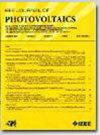Arsenic-Doped CdSeTe Solar Cells Achieve World Record 22.3% Efficiency
IF 2.5
3区 工程技术
Q3 ENERGY & FUELS
引用次数: 4
Abstract
For more than three decades, Cu has been critical to dope CdSeTe solar cells, form effective contacts, and maximize efficiency. At the same time, Cu defect chemistry has limited stability, carrier concentration, and further efficiency improvements. In this article, 22.3% world record efficiency is demonstrated without Cu by implementing As doping, which also improves stability, temperature coefficient, and energy yield. The efficiency crossing point of Group V technology relative to Cu has been driven by steady improvements in the open-circuit voltage. Here, the certified record cell reaches open-circuit voltage of 899 mV while retaining high photocurrent values of 31.4 mA/cm 2 ; the fill factor is relatively low at 78.9%. Coupling 80% fill factor with top open-circuit voltage values of 917 mV reported here offers a near-term path to 23% efficiency. Characterization indicates reducing recombination and improving activation provide viable paths to 25% efficiency.砷掺杂CdSeTe太阳能电池达到22.3%的效率世界纪录
三十多年来,铜一直是掺杂CdSeTe太阳能电池,形成有效接触和最大化效率的关键。同时,Cu缺陷化学具有有限的稳定性、载流子浓度和进一步的效率提高。在本文中,通过添加As,在不添加Cu的情况下,证明了22.3%的世界纪录效率,同时也提高了稳定性、温度系数和能量产率。V组技术相对于Cu的效率交叉点是由开路电压的稳步提高所驱动的。在这里,经过认证的记录电池达到899 mV的开路电压,同时保持31.4 mA/cm2的高光电值;填充系数相对较低,为78.9%。80%的填充系数与917 mV的最高开路电压值相耦合,可以在短期内达到23%的效率。表征表明,减少重组和提高活化是达到25%效率的可行途径。
本文章由计算机程序翻译,如有差异,请以英文原文为准。
求助全文
约1分钟内获得全文
求助全文
来源期刊

IEEE Journal of Photovoltaics
ENERGY & FUELS-MATERIALS SCIENCE, MULTIDISCIPLINARY
CiteScore
7.00
自引率
10.00%
发文量
206
期刊介绍:
The IEEE Journal of Photovoltaics is a peer-reviewed, archival publication reporting original and significant research results that advance the field of photovoltaics (PV). The PV field is diverse in its science base ranging from semiconductor and PV device physics to optics and the materials sciences. The journal publishes articles that connect this science base to PV science and technology. The intent is to publish original research results that are of primary interest to the photovoltaic specialist. The scope of the IEEE J. Photovoltaics incorporates: fundamentals and new concepts of PV conversion, including those based on nanostructured materials, low-dimensional physics, multiple charge generation, up/down converters, thermophotovoltaics, hot-carrier effects, plasmonics, metamorphic materials, luminescent concentrators, and rectennas; Si-based PV, including new cell designs, crystalline and non-crystalline Si, passivation, characterization and Si crystal growth; polycrystalline, amorphous and crystalline thin-film solar cell materials, including PV structures and solar cells based on II-VI, chalcopyrite, Si and other thin film absorbers; III-V PV materials, heterostructures, multijunction devices and concentrator PV; optics for light trapping, reflection control and concentration; organic PV including polymer, hybrid and dye sensitized solar cells; space PV including cell materials and PV devices, defects and reliability, environmental effects and protective materials; PV modeling and characterization methods; and other aspects of PV, including modules, power conditioning, inverters, balance-of-systems components, monitoring, analyses and simulations, and supporting PV module standards and measurements. Tutorial and review papers on these subjects are also published and occasionally special issues are published to treat particular areas in more depth and breadth.
 求助内容:
求助内容: 应助结果提醒方式:
应助结果提醒方式:


